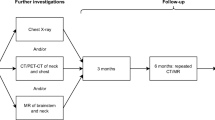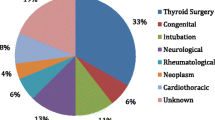Abstract
Background
Vocal fold paralysis (VFP) is sometimes the only sign of chest diseases. However, some patients with VFP due to chest diseases are not diagnosed correctly at the first examination, which may leave the patients untreated for a long time. Depending on the situation, chest x-ray is not enough for detecting the primary lesion. The objective of this study was to discuss the diagnostic procedure for VFP based on the retrospective analysis of the cases.
Methods
A total of 42 patients (29 males and 13 females) with VFP due to chest disease examined at the Department of Otolaryngology of Kyoto Prefectural University of Medicine between 1988 and 2002 were reviewed retrospectively.
Results
Of the primary chest diseases, lung cancer (15 cases) was the most common, followed by thoracic aortic aneurysm (TAA) (9 cases), metastatic tumor from other regions (6 cases), pulmonary and mediastinal tuberculosis (TB) (5 cases), and esophageal cancer (4 cases). While the primary lesions were easily detected with chest x-ray in most of the cases, some lesions in the aortopulmonary window were difficult to detect. Contrast-enhanced computed tomography (CT) was useful to detect any mass in this region.
Conclusions
In the diagnosis of VFP due to chest diseases, chest x-ray was useful but not always enough for detecting the primary lesion. Necessity of further examinations including contrast-enhanced chest CT must be kept in mind for the cases with negative chest radiographs.




Similar content being viewed by others
References
Benninger MS, Gillen JB, Altman JS. Changing etiology of vocal fold immobility. Laryngoscope 1998;108:1346–1350
Maisel RH, Ogura JH. Evaluation and treatment of vocal cord paralysis. Laryngoscope 1974;84:302–316
Ishigaki S, Shimamoto K, Satake H, et al. Multi-slice CT of thyroid nodules: comparison with ultrasonography. Radiat Med 2004;22:346–353
Glazer HS, Aronberg DJ, Lee JKT, et al. Extralaryngeal causes of vocal cord paralysis. AJR Am J Roentgenol 1983;141:527–531
Altman JS, Benninger MS. The evaluation of unilateral vocal fold immobility: is chest x-ray enough? J Voice 1997;11:364–367
Furukawa M, Furukawa MK, Ooishi K. Statistical analysis of malignant tumors detected as the cause of vocal cord paralysis. ORL J Otorhinolaryngol Relat Spec 1994;56:161–165
Author information
Authors and Affiliations
Corresponding author
Rights and permissions
About this article
Cite this article
Bando, H., Nishio, T., Bamba, H. et al. Vocal Fold Paralysis as a Sign of Chest Diseases: A 15-year Retrospective Study. World J. Surg. 30, 293–298 (2006). https://doi.org/10.1007/s00268-005-7959-x
Published:
Issue Date:
DOI: https://doi.org/10.1007/s00268-005-7959-x




